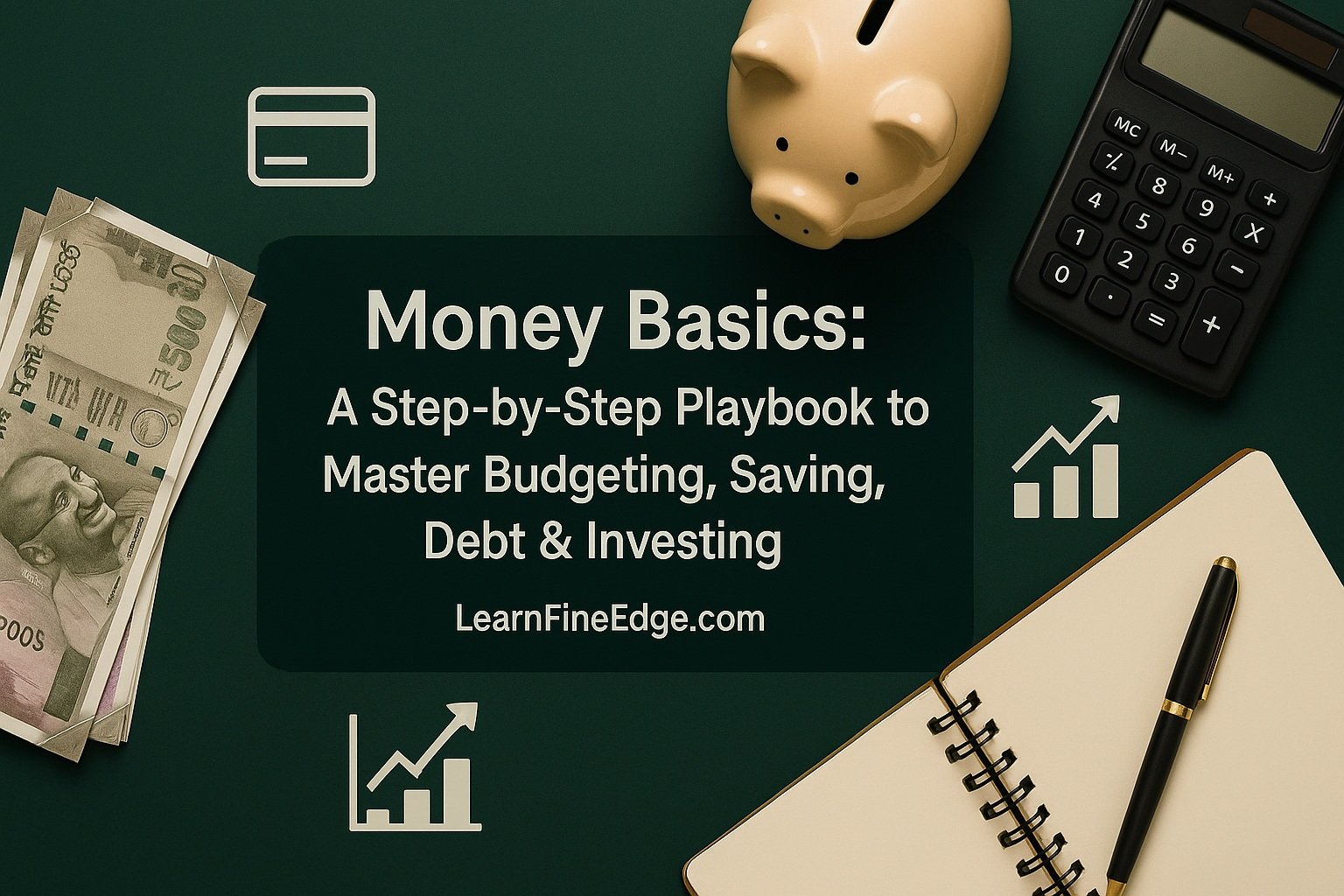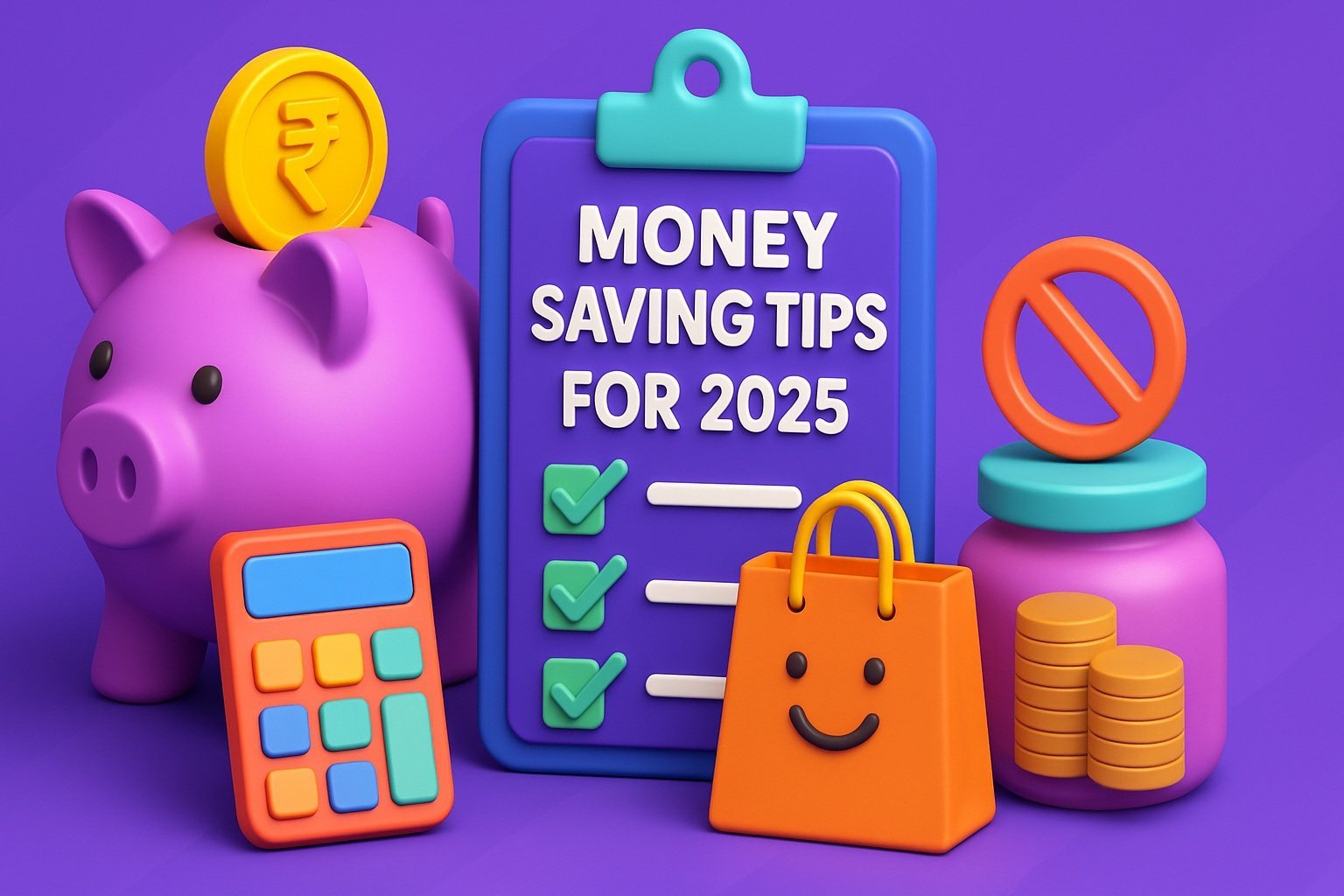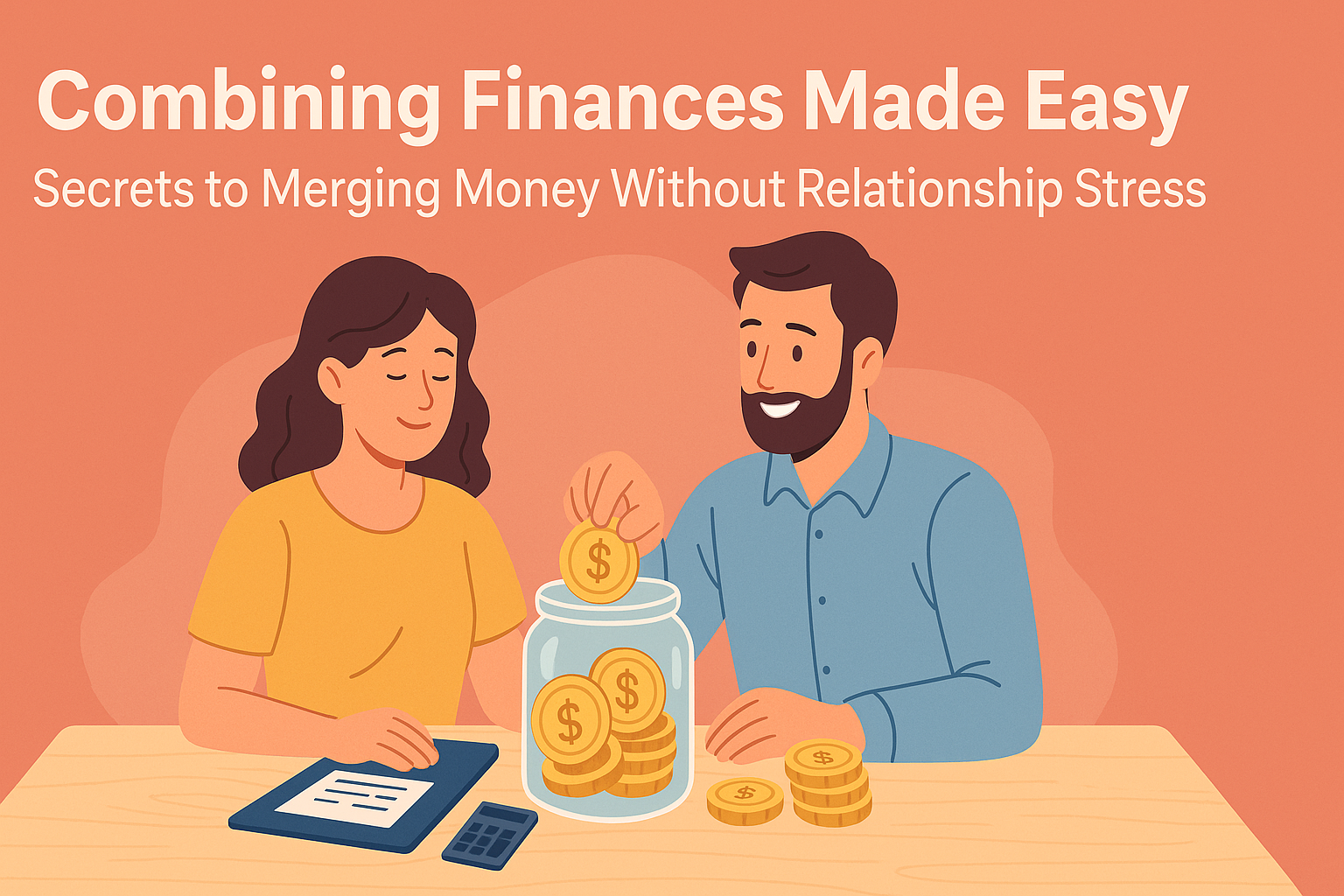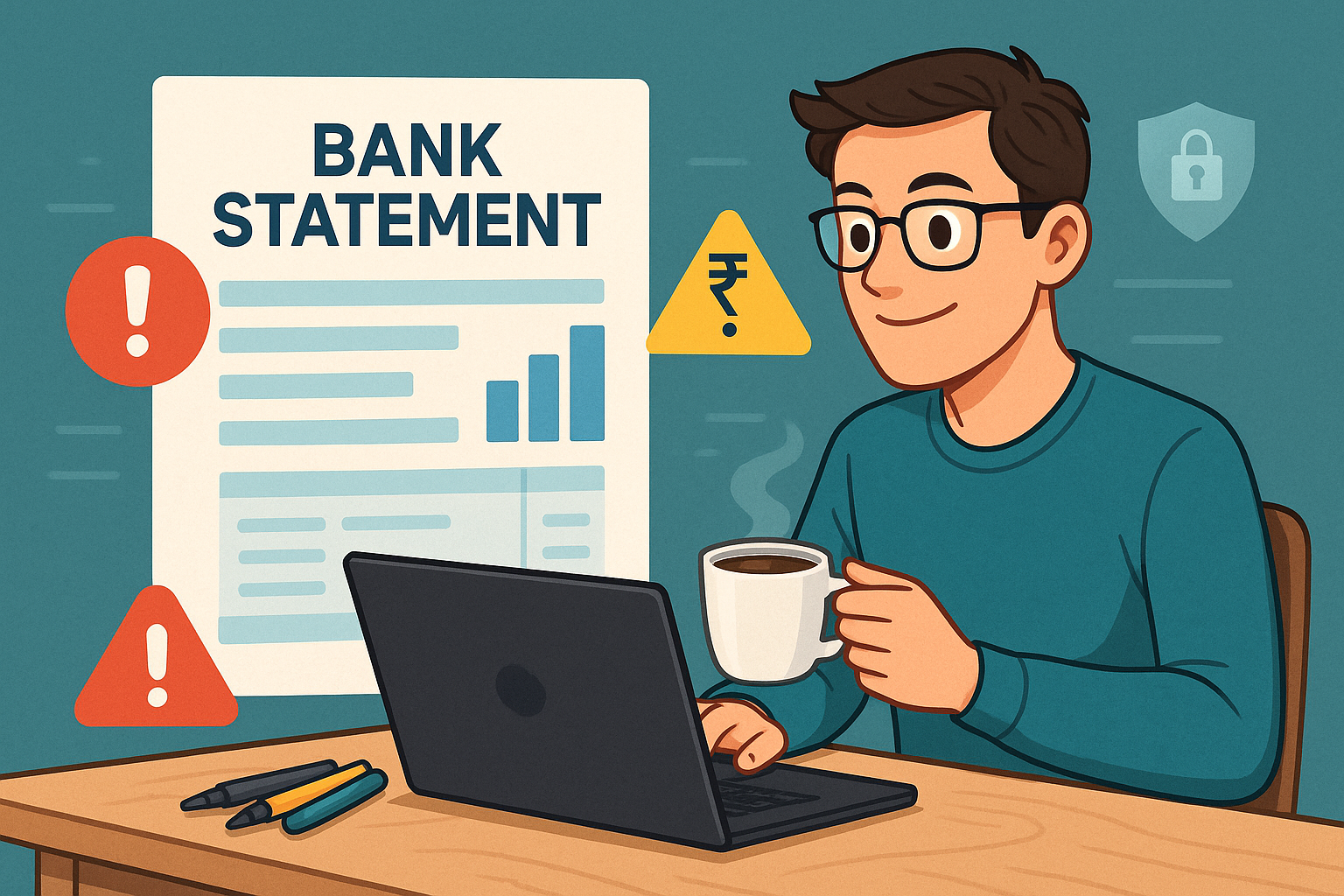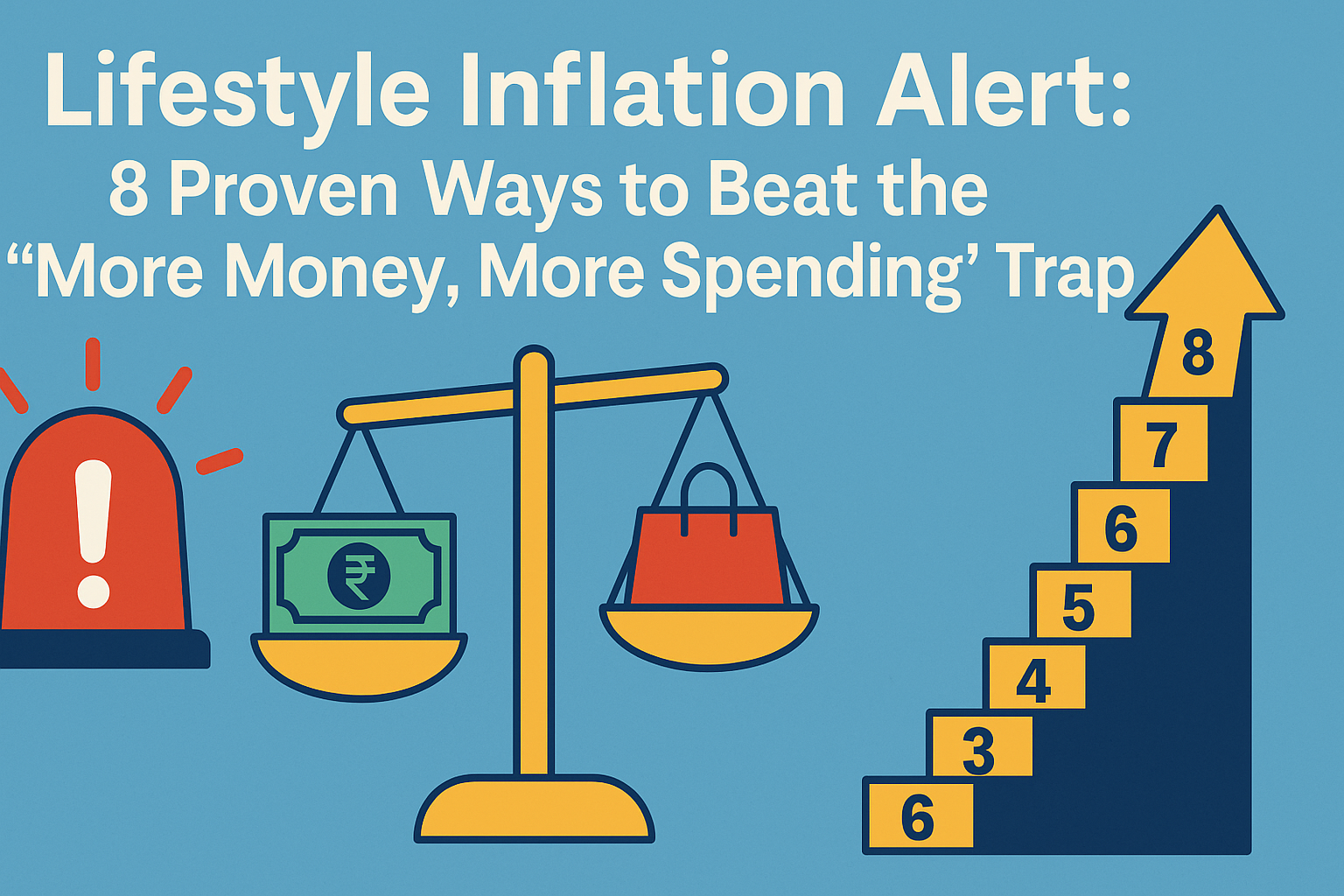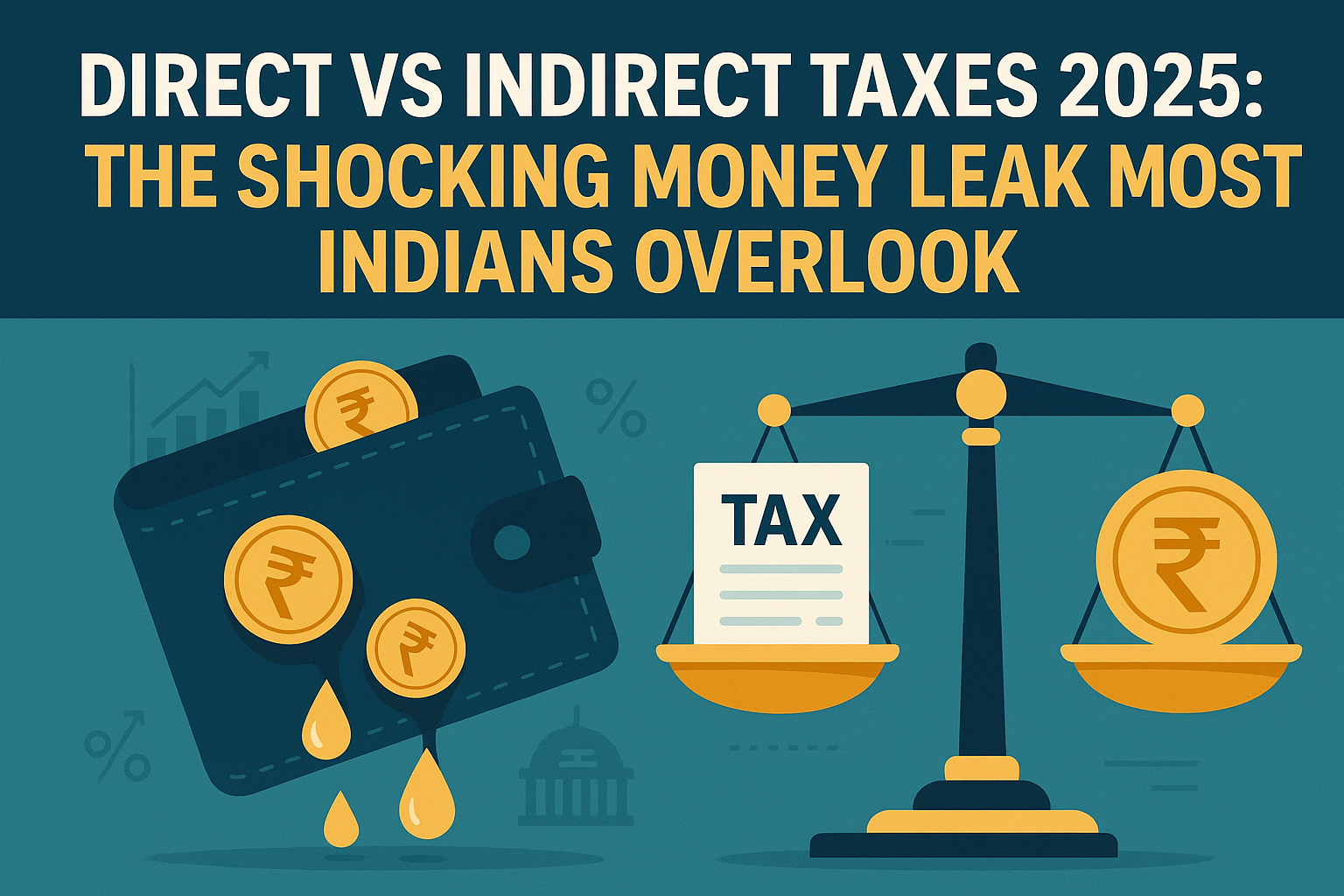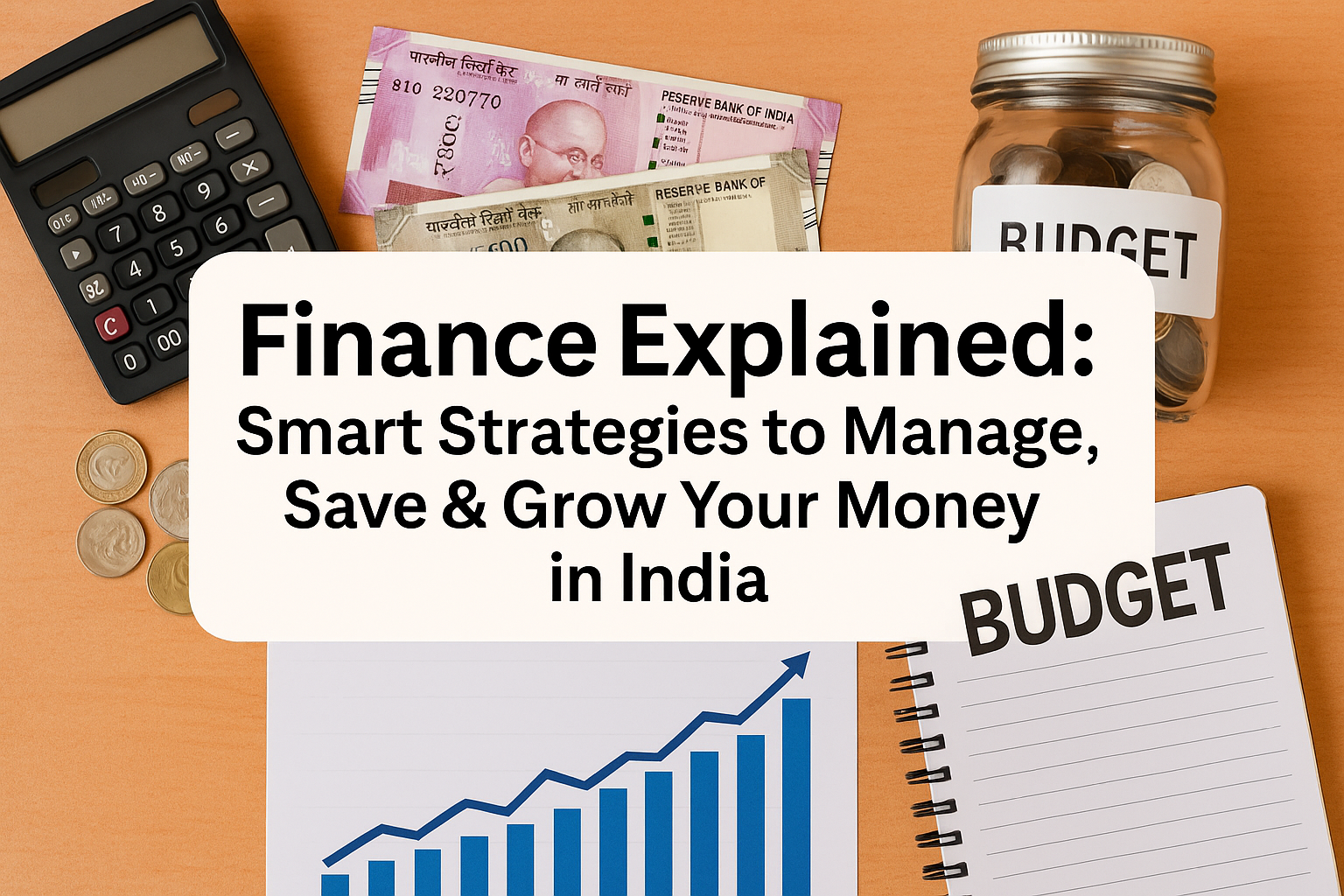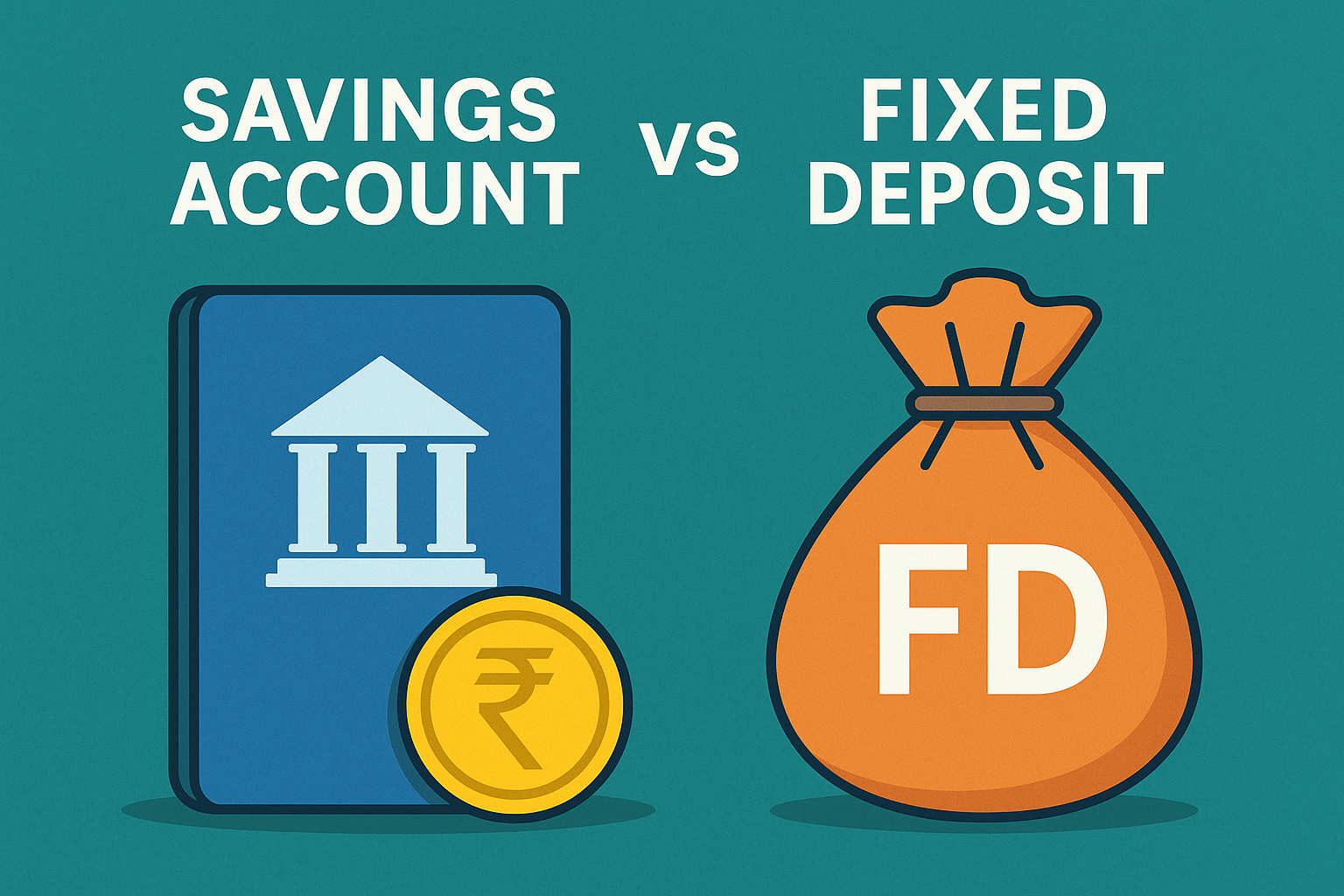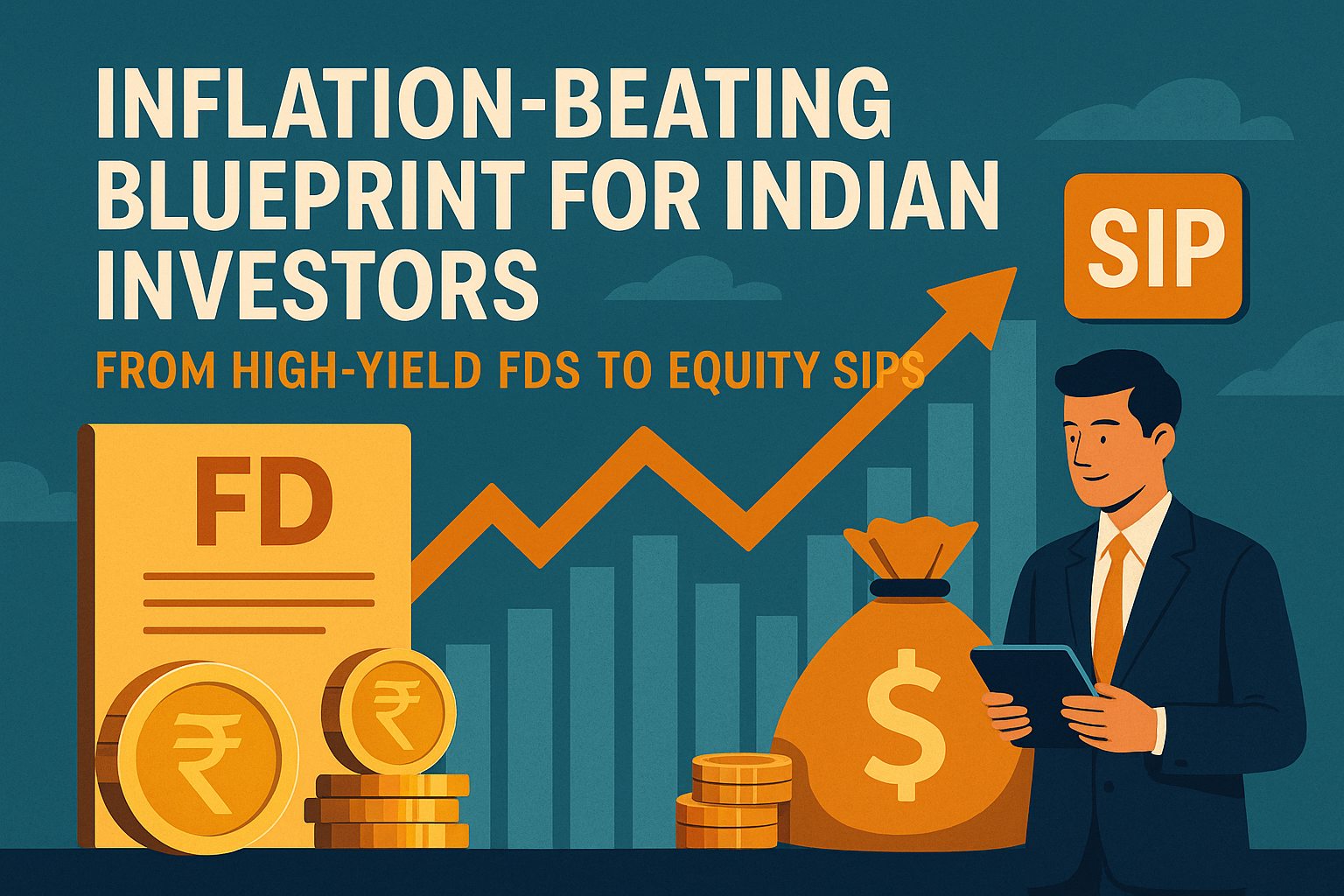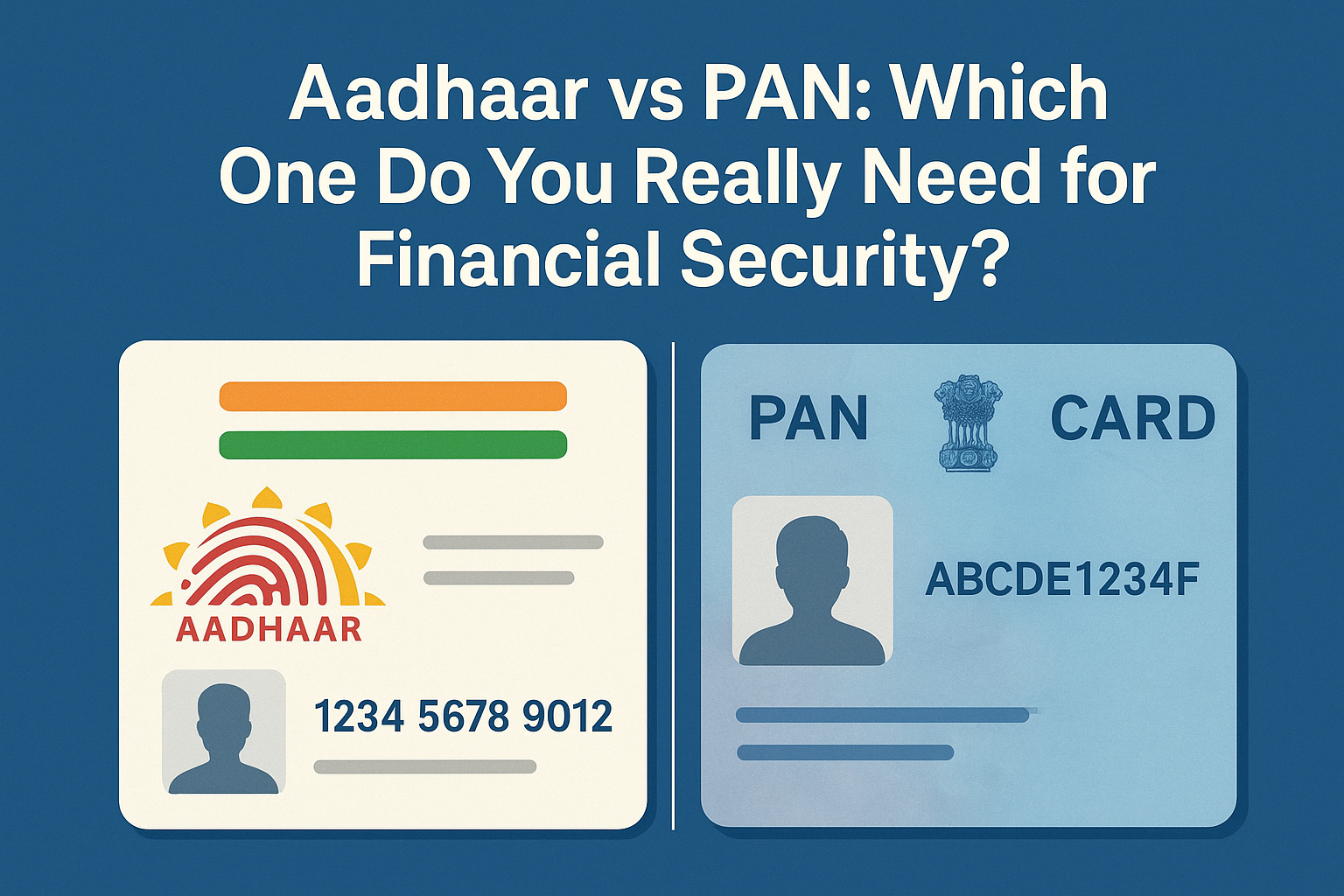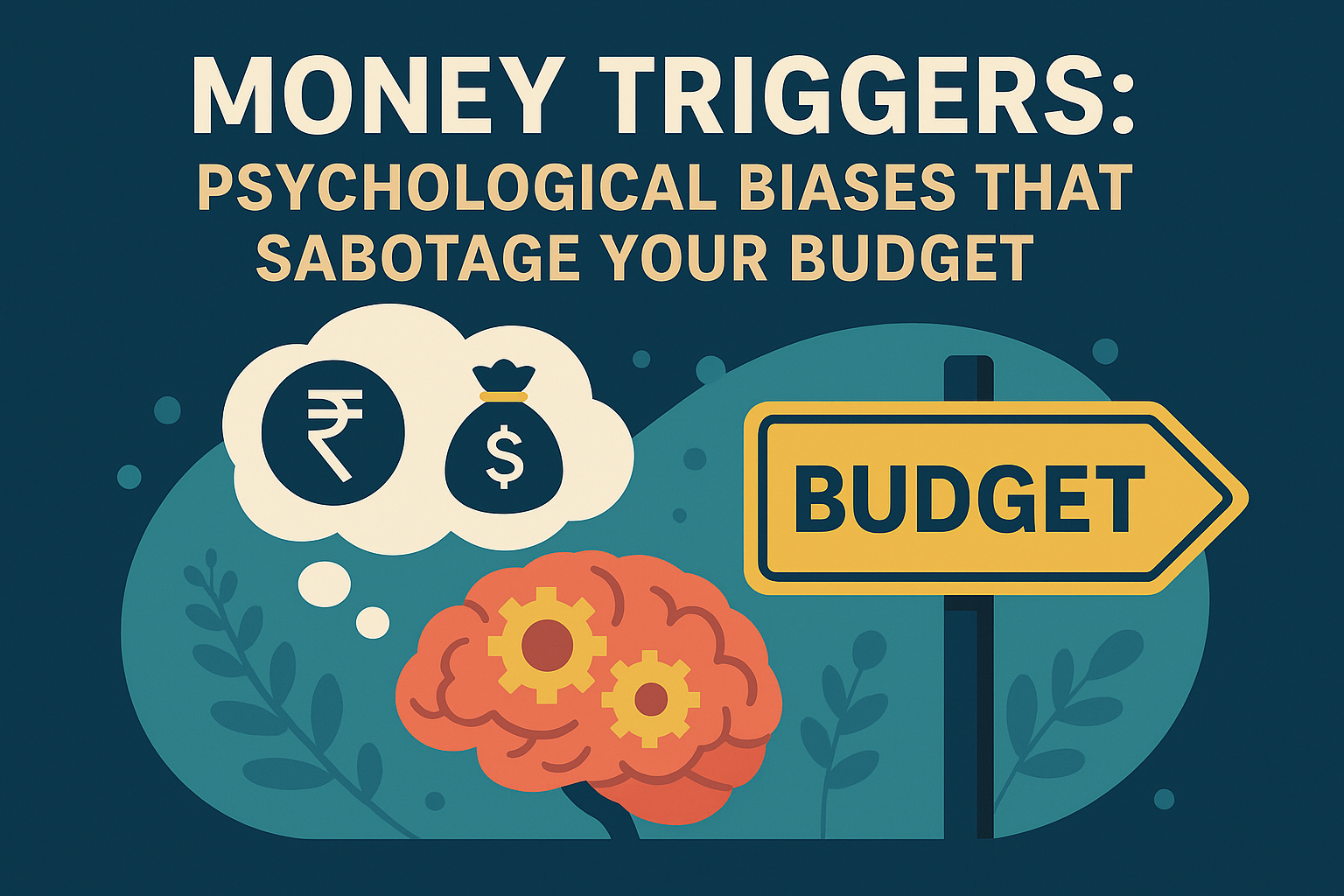
- June 5, 2025
- Dhruva
- 0
“Why did I buy that?”
If you’ve ever stared at your bank app in disbelief, you’ve met a money trigger—an internal psychological cue that slips past rational thought and turns a “maybe” into add-to-cart in seconds. These triggers are fuelled by psychological biases: hard-wired shortcuts the brain uses to save mental energy. Marketers love them. Your budget? Not so much.
Every purchase begins with a nudge from one of these biases. Perhaps it’s the illusion of scarcity: a flashing “Only 2 left!” banner that makes you abandon your careful budgeting to snag a “deal” you don’t really need. Or maybe it’s social proof—seeing reviews and star ratings prompts you to follow the crowd, even when your bank balance says you shouldn’t. Before you know it, your rational mind is sidelined, and you’ve conceded another chunk of your cash.
Anchoring bias is another culprit. When a high “original” price is shown alongside a discounted rate, your brain latches onto the inflated figure as a reference point, making the sale price seem irresistible—even if the “discount” still exceeds what you originally planned to spend. This mental shortcut short-circuits your budget’s guardrails, convincing you to overspend under the guise of “saving”.
Loss aversion plays a leading role in sabotaging your budget as well. The dread of missing out on a promotional window or loyalty points can be stronger than the satisfaction of saving in the first place. A limited-time coupon or countdown timer creates a fear-driven impulse: “If I don’t buy now, I lose out forever.” That sense of urgency overrides your carefully crafted budget limits and pushes you into impulse territory.
Framing bias further manipulates your spending. A “Free shipping on orders above ₹999” message reframes your sense of value so that adding an extra ₹300 to your cart feels justified—even if you wouldn’t have planned to spend that amount to begin with. The offer’s frame shifts your perception of what constitutes a “good deal”, and your budget quietly takes a hit.
Emotional triggers also lurk beneath the surface. Retail therapy exploits mood-driven spending biases: after a stressful day, buying something “nice” feels like an instant mood lift. That fleeting dopamine hit can be more convincing than any spreadsheet or budget rule you set. Once that euphoria wears off, the guilt settles in—and you’re left wondering where your careful planning went wrong.
If these biases are hardwired, is there any hope of outsmarting them? Absolutely. The first step is awareness: simply recognising when you’re being nudged can interrupt the autopilot spending mode. If you catch yourself feeling panicked by limited-time offers or convinced that “everyone else” is buying, pause. Give yourself a brief cooling-off period—five minutes, an hour, or even overnight before hitting “purchase”. That buffer activates your rational brain and weakens the immediate pull of the bias.
Another effective tactic is to establish clear, rule-based spending guidelines in advance. For instance, decide that you’ll only entertain discount offers on preapproved wish-list items. If you’re browsing and see a flash sale, check your list—if the sale item isn’t on it, you walk away. This explicit protocol counters the anchoring and scarcity biases by forcing a double-check: “Is this something I truly planned to buy?”
Leveraging friction can also work in your favour. Turn off one-click purchasing options, log out of shopping apps, or disable saved payment details. Introducing a small hurdle—manually typing in your credit card number or entering a verification code—creates just enough friction to disrupt the impulsive response. When that tiny barrier pops up, you have a moment to think, “Do I really need this?”
Accountability is a powerful antidote to social proof bias. Share your budget goals with a friend or family member. If you know someone else is watching your spending challenges, you’re less likely to impulsively add unnecessary items to your cart. Even a simple group chat where you post weekly expenses can bring a sense of accountability that combats the “everyone else is buying” pressure.
Mindful spending practices—tracking every rupee spent—help expose patterns that biases exploit. If you review your transactions daily, you’ll quickly see how often scarcity or loss aversion triggered an unplanned purchase. Transparency into your own behaviour shines a spotlight on recurring pitfalls and empowers you to adjust. A simple spreadsheet or budgeting app that categorises each transaction forces you to confront those biases head-on.
Automating savings before discretionary spending further weakens money triggers. Direct a fixed percentage of your income into a savings or investment account the moment you’re paid. When you see a smaller discretionary balance, you’re less tempted to overspend because the mental “puppy-food bills” line is already crossed. With less free cash visibly available, the impulsive itch to splurge finds no fertile ground.
Finally, cultivate a habit of value-based reflection. Before any purchase, ask yourself, “How does this item support my broader goals?” Aligning every expense with personal objectives—whether that’s building an emergency fund, saving for a vacation, or paying down debt—makes it harder for biases to hijack your decisions. If the answer isn’t clear or compelling, that “add-to-cart” button suddenly loses its power.
By combining awareness, intentional barriers, accountability, automation, and value alignment, you gradually recalibrate your default responses. Though marketers have perfected the art of triggering your spending biases, you can master the counterplay. Over time, the friction you intentionally introduce becomes second nature, and your budget’s guardrails hold firm. Instead of reacting to every scarcity banner, star rating, or countdown clock, you pause, assess, and choose—keeping your hard-earned money firmly under your control.
“Money triggers” refer to the automatic, emotion-driven responses that hijack the logical part of your brain—the prefrontal cortex—whenever money is involved. These triggers arise without conscious deliberation, tapping directly into System 1 thinking (fast, intuitive, and often unconscious processes), which means you frequently notice their influence only after a purchase post. By understanding the specific biases that fuel these triggers, you gain the power to spot them in action and begin neutralising their impact on your budget.
Broadly, money triggers fall into two distinct categories: external cues and internal cues. External cues are marketing or social prompts designed to ignite an impulsive reaction. Retailers deploy tactics such as flash sales (“Today only!”), scarcity messages (“Only 3 left in stock!”), and influencer endorsements (“As seen on your favourite vloggers!”) to create a sense of urgency or desirability. Under pressure from these messages, your brain shortcuts critical analysis—System 1 immediately interprets the alert as a signal that you might miss out if you don’t act now, pushing you toward a purchase you may not have planned.
Internal cues, by contrast, stem from psychological states or emotional needs. You might recognize these triggers as sudden urges when you’re stressed, bored, or seeking social validation. For instance, payday euphoria often causes you to feel flush with cash, weakening the usual budget guardrails; social comparison can make you believe that you need the latest gadget or fashion item because “everyone else has it”. Boredom prompts you to scroll through shopping apps to fill time, allowing the retail environment to exert its persuasive power. Stress, especially, can trigger a form of retail therapy—buying something “nice” in hopes of a quick mood lift. Internally generated impulses bypass the slower, analytical System 2 thinking, leading you to justify a purchase as a mood regulator rather than a necessary expense.
Because money triggers operate beneath conscious awareness, it’s crucial to recognize the typical biases that underlie them. For instance:
-
Scarcity bias (external cue): When you see an item labelled “limited stock”, your brain interprets scarcity as high value, even if that value doesn’t align with your needs or budget.
-
Social proof bias (external cue): Star ratings, influencer recommendations, and social media “haul” videos prime you to feel that if others approve, you should too—regardless of whether you can afford it.
-
Loss aversion (external and internal crossover): The fear of missing out on a deal or loyalty points can overpower the peace of mind associated with saving money.
-
Emotional spending bias (internal cue): Feelings of stress, boredom, or low self-worth trigger impulse purchases as a quick emotional fix.
-
Payday euphoria bias (internal cue): Right after receiving income, you may feel invincible and justify spending more than planned.
Below is a table illustrating common examples of external versus internal money triggers:
| Trigger Category | Description | Typical Examples |
|---|---|---|
| External Cues | Marketing or social prompts that create urgency | “Flash Sale: 50 % off today only”, “Only 3 left in stock”, influencer “haul” videos |
| Internal Cues | Emotion-driven states that override logic | Stress-induced retail therapy, boredom browsing, payday euphoria, social comparison |
When an external cue appears—say, a pop-up ad announcing a “48-hour clearance”—your System 1 thinking leaps to “act now or regret later.” You may not pause to check your budget or consider whether the purchase aligns with long-term financial goals. Similarly, when you’re experiencing an internal state like boredom, you instinctively scroll social media, exposing yourself to targeted ads and promotional posts. Without realising it, you’re primed to spend because your mood state has already weakened your rational defences.
Because these triggers operate so quickly, you usually become aware only after the transaction clears, leaving you to wonder, “Why did I buy that?” Learning about the biases that drive money triggers is the essential first step in reclaiming control. By recognising scarcity cues, spotting emotional spending impulses, and understanding how payday euphoria skews your perception, you can begin to catch the triggers in action. Once you can name them—“This is scarcity bias”, “This is emotional spending mode”—you disrupt the automatic pathway and activate your prefrontal cortex to ask, “Do I really need this?”
Top 7 Psychological Biases That Drain Your Wallet
Everyone faces psychological biases that drain your wallet, often without realising it. These mental shortcuts—hardwired into our decision-making—can override rational budgeting and push even the most disciplined spenders to overshoot their limits. Below are the top seven biases that undercut your financial goals, along with practical “budget shields” to neutralise each one.
Loss Aversion
Humans hate losing roughly twice as much as they enjoy winning. Retailers exploit this by deploying tactics such as “ends tonight” flash sales, limited-stock warnings, and generous “free-return” promises. When you see a banner announcing “Deal expires in 2 hours”, your brain interprets that message as an imminent loss if you don’t act immediately. Rather than weighing the necessity of the purchase, you feel compelled to buy in order to avoid the regret of missing out on a bargain.
Budget Shield: Frame each unplanned purchase as a guaranteed ₹-loss to your future self. Before clicking “buy”, visualise that money as already gone. Conjure a specific scenario—perhaps seeing the ₹2,000 spent today instead of added to your emergency fund—and compare that loss to the fleeting “gain” of a discounted item. By mentally “paying in advance”, you reduce the emotional sting associated with passing on a deal.
Anchoring
Anchoring is the cognitive bias where the first price you encounter becomes a reference point for how you perceive value. For example, a designer jacket originally priced at ₹5,000 but marked down to ₹2,999 feels like a steal—even if ₹2,999 still exceeds your allocated clothing budget. In this scenario, your mind latches onto the inflated “original” price as the benchmark, so the discounted rate seems irresistibly low. You end up spending more than you intended because you assume you’re “saving” thousands.
Budget Shield: Before you start browsing, write down your own target price for the item category you plan to shop for (e.g., “₹1,500 max for a casual jacket”). Keep that self-set anchor visible—on a sticky note near your workspace or as a note on your phone. When retailers present their lower sale price, your brain will compare it against your predefined threshold rather than the inflated original price. By defusing the retailer’s anchor, you stay focused on what you can genuinely afford.
Present Bias
Also called “hyperbolic discounting”, present bias favours immediate gratification over larger long-term rewards. For instance, splurging on an expensive takeout dinner tonight may feel far more appealing than saving those same rupees toward a dream vacation next year. In essence, your brain undervalues future benefits: ₹500 saved feels abstract, whereas ₹500 spent on sushi is immediate and sensory. Over time, repeated small splurges accumulate, making a dent in long-term goals like building a home down payment or paying off debt.
Budget Shield: Translate each want into hours of work or days delayed on your larger goal. For example, if you crave a ₹1,000 sushi dinner, calculate how many work hours that represents (e.g., two hours at a ₹500/hour effective rate) and visualise how many days your home down payment timeline would be pushed back by that expense. Converting that immediate desire into a tangible cost against your long-term objectives makes the trade-off starkly clear. Suddenly, tonight’s sushi loses much of its allure when you realise it costs you two days of progress.
Status-Quo Bias
Status quo bias causes people to stick with default options, even when those defaults quietly syphon money each month. Examples include gym memberships you never use, free trials that auto-renew into expensive subscriptions, or premium checking accounts with hidden maintenance fees. Since it takes effort to change the status quo, you default to letting these “small leaks” drain your bank account. Over the course of a year, these unnoticed subscriptions can total thousands of rupees, undermining your financial plan.
Budget Shield: Schedule a quarterly subscription audit notification on your calendar. At the start of each quarter, review all recurring charges: streaming services, gym memberships, app subscriptions, and premium features. If you haven’t used a given service in the past 30 days, immediately cancel or downgrade. By making this audit a regular habit, you prevent deadweight expenses from accumulating and ensure that every recurring payment aligns with active usage or genuine need.
Social Proof / Herding
Social proof, or herding behaviour, is the bias that convinces you to follow the crowd. Five-star reviews, influencer “haul” videos, and friends showing off new gadgets make you believe that buying equals belonging. Marketers deliberately flood blogs, social media, and unboxing channels with positive testimonials and endorsements so you think, “If they love it, I need it too.” The desire to fit in or keep up can override any carefully set budget limits, leading you to overspend on products you don’t truly need.
Budget Shield: Unfollow spend-trigger accounts for at least one month and replace them with creators who share saving milestones, minimalist living tips, or frugal hacks. By adjusting your social media feed, you reduce exposure to peer-pressure cues and marketing “magic”, preventing social proof from nudging you into impulsive purchases. Over time, following content that reinforces saving behaviour will strengthen your resolve and guard against herd-driven spending.
Confirmation Bias
Once you want something, confirmation bias drives your brain to seek information that justifies the purchase. Suppose you’re eyeing a new smartphone: you’ll unconsciously gravitate toward reviews praising the phone as an “investment”. You’ll dismiss or ignore any critique about expensive repairs or poor battery life. Ultimately, you only see what you want to see, rationalising your desire even if it doesn’t fit your budget.
Budget Shield: Institute a “two-source rule” for any discretionary purchase. Before deciding, consciously read at least one positive review and one negative review from reputable sources. Seek opposing data points—perhaps a professional tech reviewer pointing out long-term reliability issues or a user comment about how the gadget underwhelms. Balancing pros and cons in real time counteracts confirmation bias, enabling you to make a more objective decision.
Overconfidence Effect
Overconfidence bias leads you to overestimate future income and underestimate future costs. You might assume next month’s raise will “cover” today’s splurge on a high-end gadget or dinner out. This bias fuels the illusion that you have extra breathing room to spend, even when your current budget doesn’t support it. As a result, you take financial risks based on overly optimistic projections, and when reality strikes—bills come in higher than expected or income stalls—you end up scrambling to make ends meet.
Budget Shield: Run every discretionary purchase through a “worst-case budget” scenario that assumes flat income and a 10% increase in expenses. If, under that conservative projection, your budget still accommodates the purchase without cutting essential categories (like rent or emergency savings), you can proceed. If it doesn’t fit, pass on the purchase. This simple stress test guards against overconfident spending by forcing you to plan for less-ideal circumstances.
Below is a summary table of each psychological bias and its corresponding budget shield:
| Psychological Bias | Trigger Mechanism | Budget Shield |
|---|---|---|
| Loss Aversion | Fear of missing out on deals (“ends tonight” promotions) pushes you to spend to avoid regret. | Frame each unplanned purchase as a guaranteed ₹-loss to your future self; visualise the lost opportunity of not saving. |
| Anchoring | The first price you see (e.g., ₹5,000 marked down to ₹2,999) becomes your mental reference, making the sale price feel “cheap”. | Write a target price before shopping; use your self-set anchor to judge value, ignoring inflated original prices. |
| Present Bias | Preference for immediate gratification (takeout tonight) over larger long-term rewards (saving for vacation), leading to impulsive splurges. | Translate wants into hours of work or days delayed on goals (e.g., home down payment) to reveal the true cost of immediate spending. |
| Status-Quo Bias | Sticking with default subscriptions (gym memberships, auto-renewed trials) creates “small leaks” that add up over time. | Schedule quarterly subscription audits; cancel or downgrade any recurring charges not used in the past 30 days. |
| Social Proof / Herding | Five-star reviews, influencer “hauls”, and peer purchases convince you that buying equals social belonging, overriding rational budget decisions. | Unfollow spend-trigger accounts; follow creators who highlight saving milestones or minimalist wins to reduce exposure to herd-based spending cues. |
| Confirmation Bias | Desire to buy leads you to seek information that confirms your choice, ignoring negative data and rational objections. | Implement a two-source rule: read one pro review and one con review before any discretionary purchase to balance your decision-making. |
| Overconfidence Effect | Overestimating future income and underestimating future costs cause you to overspend based on optimistic projections. | Run purchases through a worst-case budget scenario (flat income, 10% higher expenses); only proceed if it still fits without cutting essentials. |
By recognising and addressing these top seven psychological biases—loss aversion, anchoring, present bias, status-quo bias, social proof/herding, confirmation bias, and overconfidence—you can erect mental “Budget Shields” that protect your wallet. Each shield interrupts the automatic pathways that otherwise push you toward impulsive spending, allowing your rational brain to reengage before you hit “buy”. Over time, these deliberate countermeasures strengthen your ability to resist money triggers, helping you align day-to-day spending with long-term financial goals without sacrificing occasional treats.
Trigger Detection Checklist (Self-Audit)
Regularly auditing your spending habits helps you catch recurring money triggers before they wreak havoc on your budget. Below is a simple checklist to identify whether each trigger applies to you. For each question, answer “Yes” or “No” based on your recent behaviour:
| Question | Yes / No |
|---|---|
| Do I buy more when I’m stressed or tired? | |
| Have I paid bank fees or subscription renewals I forgot about? | |
| Does a discount make me feel richer even if I’d never buy full price? | |
| Do social posts push me toward trends outside my usual spending? | |
| Do I tell myself “I’ll make it up next month” after a splurge? |
-
Do I buy more when I’m stressed or tired?
-
If you often find yourself pushing “Add to Cart” after a long day or when feeling mentally drained, that’s a classic sign of emotional spending bias. Stress and fatigue weaken your prefrontal cortex’s ability to regulate impulses, causing you to seek quick mood fixes with purchases. A “Yes” here indicates that retail therapy—or simply shopping mindlessly—is more common than you realise.
-
If you answered “Yes”: Track the context of these purchases (time of day, emotional state, recent events) to see if a pattern emerges. Are late-night cravings for snacks, clothing, or accessories consistently tied to feeling overwhelmed? Making a note each time helps you recognize that stress or tiredness often precedes unnecessary spending.
-
-
Have I paid bank fees or subscription renewals I forgot about?
-
A “Yes” response signals status-quo bias in action: you’ve allowed auto-renewals or dormant accounts to drain your balance without noticing. From forgotten streaming services to hidden maintenance fees, these small, recurring charges add up over weeks and months.
-
If you answered “Yes”: List all automatic payments and bank charges in one place. Once identified, you can decide which subscriptions to cancel or downgrade. Even if each fee is only ₹99 or ₹199 monthly, the yearly total can reach into the thousands.
-
-
Does a discount make me feel richer even if I’d never buy full price?
-
Answering “Yes” here shows how anchoring or loss aversion can hijack your logic. A ₹2,500 gadget discounted from ₹5,000 suddenly feels like an unbeatable deal, even though ₹2,500 may still exceed your budget. Retailers rely on these biases to create a perceived windfall; you feel “richer” because you’re ostensibly saving ₹2,500 when, in reality, you’re spending more than you planned.
-
If you answered “Yes”: Before clicking “Buy”, ask yourself: Would I purchase this item if it weren’t on sale? If the answer is “no”, treat that discount banner as a red flag rather than an incentive.
-
-
Do social posts push me toward trends outside my usual spending?
-
A “Yes” indicates you’re susceptible to social proof or herding behaviour. Scrolling through fashion influencers, tech reviewers, or lifestyle bloggers can subtly (or overtly) convince you that buying equates to belonging or status. Even if your budget is set on essentials, an Instagram story or YouTube haul might trigger a purchase you wouldn’t have made otherwise.
-
If you answered “Yes”: Reflect on which accounts most often lead to impulse clicks. Consider unfollowing, muting, or temporarily hiding those pages. Replace them with profiles that focus on saving, minimalist living, or financial education, so you receive fewer spending triggers.
-
-
Do I tell myself “I’ll make it up next month” after a splurge?
-
If you frequently rationalise overspending with future promises, that’s a sign of present bias or even the overconfidence effect—you assume next month’s income will cover today’s extras. This autopilot mindset delays accountability and often leads to a cycle of debt or chronic under-saving.
-
If you answered “Yes”: Keep a running tally of these “temporary deficits”. When that mental note appears, pause and consider, “If I don’t actually make it up next month, what’s the consequence?” Visualising a shortfall motivates you to stick to your budget rather than defer responsibility indefinitely.
-
Action Plan
Once you’ve completed the checklist, take these concrete steps to diagnose and disrupt your primary money triggers:
-
Pull your last 10 impulse purchases.
-
Open your banking or credit card app and identify purchases made without prior planning. Look for small-ticket items (₹500–₹2,000) that you didn’t include in your monthly budget. Grocery “splurges”, online deals, in-app game purchases, or miscellaneous retail orders all count.
-
-
Match each to the bias list above.
-
For every impulse buy, ask, “Was I stressed? Did I see a discount? Did a social post influence me? Did I think I’d ‘make it up later’? Tag each purchase with one of the seven biases (loss aversion, anchoring, present bias, status quo bias, social proof, confirmation bias, overconfidence). Creating a simple chart helps:
Purchase Date Approx. Cost Detected Bias Late-night snack app May 10, 2025 ₹450 Emotional spending Flash-sale T-shirt May 12, 2025 ₹799 Anchoring Streaming auto-renewal May 15, 2025 ₹299 Status-quo bias Influencer gadget buy May 18, 2025 ₹1,499 Social proof Payday dinner splurge May 20, 2025 ₹1,200 Present bias (euphoria)
-
-
Tally which bias appears most. That’s your primary trigger.
-
Count the frequency of each bias across your ten impulse buys. For example, if you discover that four out of ten purchases stemmed from seeing discounts (anchoring) and only one from social media influence, anchoring is your top culprit. Recognising the dominant bias lets you focus intervention efforts where they matter most.
-
-
Note the context (time of day, emotion, platform) for patterns.
-
Beyond simply naming the bias, log the conditions that coincided with each purchase. Was it a midday slump on a weekday? A late-night weekend scroll through your favourite shopping app? Documenting details like these helps you pinpoint vulnerable windows—perhaps you’re most impulsive right after work or on certain websites.
-
-
Set one concrete prevention tactic for the coming week.
-
Base your tactic on your primary trigger and context patterns. Examples include:
-
If stress-driven buys dominate: Schedule a five-minute breathing exercise whenever you feel the urge to shop. Use that time to reflect on whether the purchase aligns with your monthly goals.
-
If discounts lure you: block shopping websites or uninstall retail apps during peak browsing hours.
-
If subscription renewals slipped by, set a single calendar reminder labelled “Audit Subscriptions” for every Sunday; cancel or downgrade unused services immediately.
-
-
Choose only one tactic for the week—focusing on a single change increases your chance of actually following through. At the next week’s end, review whether that prevention step reduced impulse buys and refine your approach as needed.
-
By systematically completing this self-audit and following the action plan, you’ll uncover hidden patterns that fuel impulsive spending. Identifying your primary bias and its triggers equips you with targeted defences, helping you make intentional, rational choices rather than inadvertently letting psychological shortcuts drain your wallet.
Step 1 — Pause & Label
When a sudden urge to spend hits—whether it’s an email announcing a “flash sale”, a social media post flaunting a new gadget, or just an internal craving after a stressful day—stop for at least 30 seconds and mentally shout the bias at play: “Anchoring!” or “Loss aversion!” Labelling the urge recruits your prefrontal cortex, interrupting the knee-jerk System 1 response. Research shows that simply naming the bias can cut impulsive decisions by up to 30 percent. By pausing long enough to identify whether you’re reacting to a scarcity cue (“Only three left!”), social proof (“Everyone’s buying this”), or another money trigger, you create a critical pause for rational thought. In those 30 seconds, ask yourself:
-
What bias is attempting to hijack my decision?
-
Has this tactic worked on me before?
-
Do I truly need this right now?
This simple mental check transforms autopilot spending into a deliberate choice, dramatically reducing impulse buys.
Step 2 — Reframe Costs as Hours Worked
Our brains undervalue future consequences and overvalue immediate gains—so a ₹6,000 gadget may feel “affordable” until you convert it into time. Divide the price by your net hourly pay. For example, if you earn ₹750 per hour after taxes, a ₹6,000 smartphone represents eight hours of your life. Ask yourself, “Is it worth dedicating an entire workday to this purchase?” This reframing technique taps into the same logic that motivates you to avoid overtime or unnecessary shifts—nobody wants to trade eight hours of hard-earned labour for a fleeting thrill. By translating rupees into hours, you shift from abstract rupee amounts to tangible time. That connection forces a deeper evaluation:
-
If eight hours worked could instead fund groceries or accelerate debt payoff, is the gadget still worthwhile?
-
Does that single purchase delay a larger goal—like a vacation or emergency fund—by a full day of effort?
Making costs concrete in terms of your own time helps override present bias and makes it far less likely you’ll click “purchase” without reflection.
Step 3 — Set Pre-Commitment Guardrails
Spending impulses often strike at vulnerable moments, so bake friction into the process before temptation can take hold. Introduce one or more of the following guardrails:
-
24-hour rule for non-essentials over ₹2,000: For any discretionary item above a set threshold, require a full day of waiting before buying. That delay allows emotional urges to subside and gives your rational mind time to re-evaluate the true need.
-
Card-issuer purchase limits: Set a daily or weekly spending cap on credit or debit cards. If you must exceed that limit, you’ll need to call your bank or manually override the cap—adding friction that encourages reconsideration.
-
Wallet-free days: Designate specific days each month when you leave all payment apps and cards at home. When you can’t easily buy, you break recurring patterns of habitual browsing and impulsive checkout.
-
Separate “fun money” debit card: Load a fixed amount of discretionary cash onto a secondary card each week. Once funds deplete, no more impulsive treats are possible until the next reload.
These guardrails transform sheer willpower into structural barriers. By committing in advance to wait, limit, or remove payment methods, you ensure that fleeting desires can’t override your budget. Over time, these pre-commitments become habitual, making it easier to resist money triggers before they ever materialise.
Step 4 — Automate Needs, Isolate Wants
Decision fatigue is a silent budget killer. Every time you weigh “needs versus wants”, you expend mental energy, making it easier to give in to impulsive spending later. Automate your core financial flows to reduce daily friction:
| Bucket | Purpose | Automation Method |
|---|---|---|
| Account A (Needs) | Essential expenses (rent, groceries, utilities) | Set up auto-pay for bills directly from Account A on payday. |
| Account B (Goals) | Savings and investments (emergency fund, retirement) | Schedule an automatic transfer of a fixed percentage (e.g., 20 percent) from your salary to Account B each payday. |
| Account C (Wants) | Discretionary spending (dining out, shopping) | Let Account C receive the remaining balance. Once it hits zero, no more spending until the next pay cycle. |
Routing your salary into these three distinct buckets eliminates guesswork. Account A covers unavoidable costs first, ensuring bills never bounce. Account B funnels money into your long-term goals without requiring a monthly reminder. Account C holds only what’s safe to spend on non-essentials. When Account C is empty, you’ve effectively “spent” your fun money—no need to think twice. Since automatic transfers occur immediately after payday, the dreaded “I’ll save later” mindset disappears; you see your true discretionary balance at all times. Automation removes decision fatigue and empowers your rational self to focus only on planned spending, making it far less likely you’ll cave to fleeting impulses.
Step 5 — Review & Reward
Building lasting financial discipline requires ongoing feedback loops. At the end of every week, carve out ten minutes to debrief:
-
Note bias-driven wins: Document occasions when you successfully identified a trigger—perhaps you paused and labelled an email sale or skipped that midnight snack purchase after reframing costs as hours worked.
-
Identify slips: Acknowledge any impulsive buys that occurred despite your guardrails. Pinpoint which bias misled you and consider how to adjust your tactics.
-
Adjust rules: If you notice that a ₹2,000 threshold is too low—maybe most of your temptations cluster at ₹1,500—lower the limit. If a 24-hour wait is being bypassed, extend it to 48 hours. Tweaking these guardrails keeps them aligned with real-world patterns.
-
Reward success with a $0 treat: Reinforce positive behaviour by treating yourself in a cost-free way—stream a favourite movie using existing subscriptions, spend an extra hour at the gym, or indulge in a relaxing long bath. Positive reinforcement cements new habits more effectively than self-reproach.
By combining regular reflection with non-monetary rewards, you strengthen the neural pathways that favour budget-friendly decisions. Weekly reviews transform isolated moments of self-control into a broader pattern of mindful financial management. Over time, recognising triggers, reframing expenses, automating flows, and reinforcing positive outcomes coalesce into a sustainable strategy.
Real-Time Alerts
Most banking apps offer real-time notifications for every transaction that exceeds a threshold you set—say, ₹500 or ₹1,000. By receiving an instant push or SMS alert the moment a debit posts, you feel immediate “pain of paying”, which steers you away from repeated impulse spending. When your phone buzzes with a “₹899 purchase at FoodieExpress” notification, you pause to ask, “Do I really need this?” Over time, these real-time alerts train your brain to link each swipe or tap with an immediate consequence, reducing the likelihood that you’ll drift into unconscious splurges. Configure alerts not only for debits but also for credits—seeing a salary deposit followed by a reminder to save a percentage right away keeps your goals front of mind.
Card Locks & Limits
Freezing online spending outside fixed hours or setting daily caps on debit and credit cards introduces friction exactly where impulsivity kicks in. For instance, you might schedule your card to be “locked” for all e-commerce transactions between 9 p.m. and 6 a.m., a notorious window for late-night, emotion-driven shopping. Many apps let you slide a toggle to suspend international or online purchases entirely with one tap. Daily or weekly spending limits (e.g., ₹2,000 per day or ₹10,000 per week) force you to pause when you try to exceed the cap: a pop-up appears saying, “Limit reached—call to override.” That extra step—logging into the banking app or calling customer service—gives you a moment to reflect and often leads you to abandon nonessential buys. In effect, card locks and limits turn your financial willpower into a built-in barrier, ensuring your rational self has a chance to reassert control.
Browser Plug-ins
Browser extensions weaken the psychological hooks that retailers and credit card issuers rely on. Tools like Keepa provide detailed price-history graphs for Amazon listings, so you can see whether today’s “sale price” is genuinely the lowest or just another inflated anchor. When a gadget you planned to buy for ₹3,499 was selling for ₹3,199 last week, that transparency curbs your urge to click “Buy Now”. Other plug-ins calculate the “true cost after interest” for credit-card shoppers. For example, if you see a ₹10,000 purchase but the tool shows it will actually cost ₹12,500 over six months with interest, you’re far less likely to justify the buy. A small table below summarises common extensions and their core functions:
| Browser Plug-In | Primary Function |
|---|---|
| Keepa | Displays historical price charts on e-commerce sites |
| Credit Card Cost Calculator | Shows total cost including interest and fees |
| Honey | Automatically searches for coupon codes, reducing friction in price hunting (use cautiously to avoid anchoring traps) |
| Unroll.Me | Aggregates and unsubscribes from promotional emails to reduce temptation |
By installing these extensions, you expose marketing tactics to sunlight. When the “70% off” label no longer shocks you into buying, your budget remains intact.
Habit Trackers
Apps such as Habitica or Strides transform no-spend days into a gamified experience. Habitica, for instance, turns each money-saving goal into a “quest” where you earn virtual rewards for logging days without discretionary purchases. Strides lets you set a “no-spend” streak counter, complete with reminders and progress charts. When you see a rising streak—“You haven’t spent on wants for 14 consecutive days!”—you gain social and psychological reinforcement to keep the streak alive. Habit trackers also tap into accountability by letting you share milestones with friends or an in-app community. As you check off each no-spend day, the urge to break the chain weakens. By converting disciplined spending into an engaging challenge, these tools rewire your dopamine pathways so that saving feels as rewarding as splurging once did.
Accountability Buddies
Sharing your monthly statements or weekly expense summaries with a trusted friend, partner, or financial coach creates an external layer of scrutiny that beats the pull of social-proof marketing. When you know your accountability buddy will review your debit card charges or subscription list, you’re less likely to authorise frivolous spends. Set up a shared spreadsheet or use an app that lets you both comment on individual transactions—seeing a “ Unplanned ₹1,200 streaming upgrade” flagged by someone else feels more real than a self-imposed budget reminder. Discuss your goals: perhaps you and your buddy agree on a joint target of “no eating out more than twice per month”, and each of you holds the other to that promise. This social-contract approach injects constructive peer pressure into your financial habits. Since we humans naturally value reputation and belonging, a friendly check-in often trumps an impersonal bank notification. Over time, these check-ins train your brain to anticipate social scrutiny, making you less susceptible to marketing-driven impulses.
FAQ – People Also Ask
What is the most common psychological bias in overspending?
Loss aversion tops the list because retailers weaponise it with scarcity messaging. When you see alerts like “Only two seats left!” or “Sale ends in 2 hours”, your brain interprets that as a looming loss. You’re wired to avoid losses more intensely than you seek gains—losing ₹500 feels nearly twice as painful as gaining ₹500 feels pleasurable. As a result, scarcity cues trigger snap purchases. Even if you didn’t plan to buy, the fear of missing out convinces you that passing on this “deal” equals a guaranteed loss. Retailers know that once scarcity messaging activates loss aversion, you’re far more likely to override your budget guardrails. By understanding that loss aversion drives these quick decisions, you can pause before clicking “buy” and ask, “Am I truly avoiding a loss, or am I falling for a marketing ploy?”
How can I stop impulse buying triggered by emotions?
Implement a mood log. When you feel the urge to spend—whether stress, boredom, or frustration—note the specific emotion in a dedicated journal or app. Write down what you’re feeling (“anxious after work”, “bored during lunch break”) and delay checkout for 24 hours. Data shows that a 24-hour delay breaks about 80 percent of emotion-led purchases. During that waiting period, revisit your note: has the original emotion subsided? If not, consider non-spend stress relievers such as a brief walk, calling a friend, or a short meditation session. By logging your mood and pausing for a full day, you intercept the automatic drive to purchase and give your rational brain time to reengage. When the emotional intensity fades, you can decide whether the item still makes sense within your budget.
Do budgeting apps really prevent cognitive biases?
Budgeting apps reduce some biases but cannot replace conscious guardrails like the 24-hour rule. For example, automatic categorisation exposes status-quo fees—if you forget about a recurring subscription, the app flags it so you can cancel unused services. Real-time spending alerts fight present bias by making you feel immediate “pain of paying” whenever you swipe your card. However, no app can fully eliminate anchoring or social proof biases, because those operate in your mind when you browse external sites. You still need manual guardrails—such as setting purchase thresholds or enforcing a waiting period—to counteract impulses. In summary, while budgeting apps shine a spotlight on hidden leaks and prompt reflection, they work best when paired with intentional strategies that target deeper cognitive shortcuts.
Is retail therapy a legitimate stress-relief method?
Research finds retail “highs” fade within 20 minutes, often followed by regret. The temporary dopamine spike you get from buying something new quickly dissipates, leaving you with the same stress or boredom—and a lighter wallet. Non-spend stress relievers such as exercise, calling a friend, or journaling produce longer-lasting mood boosts with no financial hangover. For instance, a 20-minute walk or a 10-minute phone call with a supportive friend can release endorphins and help you process emotions more effectively than a fleeting shopping spree. Although the thought of retail therapy can seem comforting in the moment, the short-lived satisfaction rarely justifies the long-term budget consequences. Instead, choose coping mechanisms that foster emotional resilience without draining your checking account.
How long does it take to retrain spending habits?
Behavioural studies suggest 8–12 weeks of consistent practice is required to rewire cue-response loops. During this period, pairing your 5-step strategy (Pause & Label; Reframe Costs as Hours Worked; Set Pre-Commitment Guardrails; Automate Needs, Isolate Wants; Review & Reward) with weekly reviews accelerates the process. Each week, track when you identify a bias, how often you delay purchases, and which guardrails prevented overspending. Over eight weeks, your brain receives repeated reinforcement that urges to spend can be paused, examined, and redirected. By the end of this timeframe, recognising triggers like loss aversion or present bias becomes second nature, making impulsive shopping far less frequent. Consistency is critical: if you miss a week of reviews or bypass the 24-hour rule, the retraining process slows. But with steady application, most people see a noticeable shift in automatic spending impulses within two to three months.


